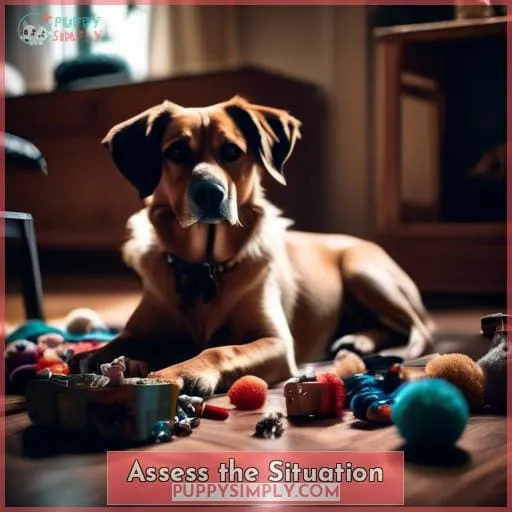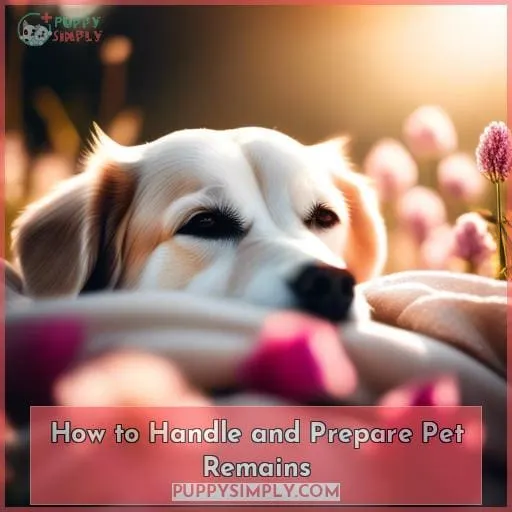This site is supported by our readers. We may earn a commission, at no cost to you, if you purchase through links.
 Imagine your dog’s tail wagging furiously,
Imagine your dog’s tail wagging furiously,
their eyes filled with unconditional love,
a permanent fixture by your side.
Now picture that light extinguished,
a void left in its place.
When your beloved dog dies,
it’s a gut-wrenching experience.
But with the right steps,
you can navigate this difficult time
with grace and love.
Here’s a step-by-step guide
to help you cope with the loss
of your furry best friend.
Table Of Contents
- Key Takeaways
- Assess the Situation
- Contact Your Veterinarian
- Call for Help
- Handling the Body
- How to Handle and Prepare Pet Remains
- Burying Your Dog’s Body
- Create a Memorial After the Loss of a Pet
- When to Get a New Pet
- Frequently Asked Questions (FAQs)
- What are some unique ways to memorialize my dog’s life and keep their memory alive?
- How can I help my young children cope with the loss of our family pet?
- Are there any specific rituals or traditions that can help me process my grief and say goodbye to my dog?
- What are some ways to ensure that my dog’s final days are as comfortable and peaceful as possible?
- How can I involve my other pets in the grieving process and help them adjust to the loss of their companion?
- Conclusion
Key Takeaways
- Prepare the body by confirming death, placing it in a dignified location, and contacting the veterinarian for guidance.
- Create a peaceful environment by dimming lights, playing calming music, and surrounding the body with comforting items.
- Contact the veterinarian promptly to discuss aftercare options, such as burial, cremation, and grief counseling.
- Handle the body by storing it in a cool, dry place, embalming or freezing it for preservation, and selecting a suitable casket or container for burial or cremation.
Assess the Situation
When your dog’s time comes, you’ll need to take some immediate steps:
- First, confirm their death by checking for a heartbeat and breathing.
- Then, place their body in a dignified and respectful location, like a soft blanket in a quiet room.
- Finally, contact your veterinarian or animal control for guidance on what to do next.
Confirm Pet’s Death
In the unfortunate event of your beloved dog’s passing, begin by gently checking for signs of life.
Feel for a heartbeat or shallow breaths, but avoid shaking or moving their body excessively.
-
Check for a Pulse:
- Place your hand on their chest near the elbow, feeling for a faint thump.
- Look for subtle chest movements or fogging on a mirror held near their nose.
- If their body is stiff and rigid, rigor mortis has likely set in, indicating death.
Confirming your dog’s death is a difficult but necessary step. Stay calm and composed as you prepare for the next steps of burial preparation or professional assistance.
Create a Peaceful Environment
After confirming your dog’s death, create a serene space for your furry friend to rest peacefully.
Surround their body with soft blankets, their favorite toys, and photos of cherished memories.
Dim the lights, play calming music, and open windows to let in fresh air.
This tranquil environment will offer solace during this time of grief, aiding in the process of coping with the loss of your beloved companion.
Comforting Actions:
- Light a scented candle
- Play soothing music
- Arrange flowers near your pet
- Place their favorite blanket over them
Coping Mechanisms:
- Journal your emotions
- Seek support from pet bereavement services
- Join a pet loss support group
- Talk to a trusted friend or family member
Contact Your Veterinarian
Reach out to your veterinarian promptly to inform them of your dog’s passing.
They’ll guide you through the process of aftercare, whether you choose burial, cremation, or another option.
They’ll also help you cope with your loss.
Notify Vet Immediately
Calling your veterinarian after your dog’s death ensures prompt guidance.
- Handling the body
- Discussing aftercare options
They can provide:
- Emotional support
- Help with cremation preferences
- Burial location
- Grief counseling
- Support groups
Don’t hesitate to reach out; their expertise and compassion can be invaluable during this difficult time.
Discuss Aftercare Options
How will you handle your dog’s final arrangements, such as cremation or burial, with your veterinarian?
Discuss your preferences and budget.
Inquire about pet memorial options like urns and ash scattering.
Explore pet afterlife beliefs and rituals that resonate with you.
Ask about grief counseling services to help you navigate this difficult time.
Call for Help
If you’re unable to drive or need assistance with transporting your dog’s body, don’t hesitate to reach out to friends, family, or professional transportation services.
They can provide the support you need during this difficult time.
Seek Assistance From Friends or Family
With your veterinarian notified, reach out to friends or family for assistance in transporting your pet’s body.
Their presence can provide emotional support during this difficult time.
Additionally, consider joining pet loss support groups or seeking guidance from pet loss counselors or therapists.
These resources offer coping mechanisms and a supportive community to help you navigate the stages of grief associated with losing a beloved companion.
Consider Professional Transportation Services
Considering professional assistance eases the burden of transporting your beloved dog’s remains.
Compare costs and services of pet funeral planning companies and transportation options.
Professional services can handle everything, from transporting your pet to preparing their final resting place.
Pet insurance may cover these expenses.
Funeral planning ensures your dog’s afterlife journey is handled with care and respect.
Handling the Body
If your dog passed away at home, you’ll need to prepare for decomposition.
Store the body in a cool, dry place, like a refrigerator or freezer, to slow the process.
You may also want to contact a pet cemetery or crematorium to make arrangements for the body’s final resting place.
Prepare for Decomposition
Once your veterinarian confirms your dog’s death, you’ll need to prepare for decomposition.
Act quickly, as decomposition begins within hours, especially in warm weather.
Cool the body by placing it in a cool, dry location, or consider using ice packs.
You may choose to preserve the remains by embalming or freezing the body.
If you plan to bury your dog, select a meaningful location and consider a pet cemetery for proper care and maintenance.
Store the Body Properly
Keep your dog’s body chilled if you must delay burial or cremation.
Explore embalming options to preserve the body for a longer period.
Refrigeration can slow decomposition, but you’ll need a large enough space.
Dry ice or ice packs can also help preserve the body temporarily.
Choose a casket or container that’s suitable for burial or cremation, considering factors like size, material, and cost.
Plan the burial or cremation as soon as possible to avoid further decomposition.
How to Handle and Prepare Pet Remains
Now that you’ve said goodbye to your beloved dog, you’ll need to decide between burial and cremation.
Learn about any legal considerations that may apply in your area.
It’s a good idea to begin researching local pet cemeteries and crematories to help you make an informed choice.
Choose Between Burial and Cremation
After preparing your pet’s body for their final farewell, you’ll need to decide between burial and cremation.
Consider the cost comparison, environmental impact, personal preference, religious considerations, and legal regulations in your area.
Burial allows for a dedicated resting place, while cremation provides a portable memorial.
The choice is yours, but ensure it aligns with your emotions and beliefs.
Understand Legal Considerations
- Before deciding between burial or cremation, check local regulations and any specific restrictions in your area.
Familiarize yourself with legal requirements, burial permits, and cremation laws.
Understanding pet ownership rights and local regulations will ensure you handle your beloved companion’s remains respectfully and in compliance with the law.
Burying Your Dog’s Body
When faced with the loss of your beloved dog, choosing a meaningful location for burial can be a comforting and personal way to honor their memory.
Consider the possibility of a pet cemetery, where your dog can rest in a peaceful and dedicated space, surrounded by other cherished companions.
Select a Meaningful Location
When burying your dog’s body, select a meaningful location that evokes fond memories and signifies your unique bond.
Consider spots where you shared joyous moments:
- Beneath their favorite tree
- By the stream where they loved to play
- Near a hiking trail you often explored together
Let your heart guide you to a place that resonates with your pet’s spirit and your shared history.
Consider a Pet Cemetery
Consider a pet cemetery if you’re seeking a designated and respectful resting place for your beloved dog.
Pet cemeteries offer various options, from simple gravesites to elaborate memorials.
Costs vary, so research different cemeteries to find one that fits your budget and preferences.
Before choosing a location, consider factors like proximity to your home, visiting hours, and rules regarding decorations and memorials.
Many pet cemeteries also offer cremation services and memorialization options like personalized headstones or plaques.
Create a Memorial After the Loss of a Pet
As you grieve the loss of your beloved dog, consider creating a memorial to honor their memory.
Plant a tree or flowers in their favorite spot in the yard, or create a special place in your home to display photos and mementos of your time together.
Sharing your feelings and memories with friends and family can also be a comforting way to celebrate your dog’s life and legacy.
Share Your Feelings
Often, you’ll share your feelings and memories of your beloved dog with friends, family, and even strangers.
Expressing emotions and sharing memories is a natural way to honor your dog’s life.
Don’t shy away from seeking support from loved ones or pet loss support groups.
Talking about your dog and the memories you shared can help you cope with the loss and begin the healing process.
Plant a Tree or Flowers
Plant a tree or flowers in your yard as a living memorial to your beloved dog.
Choose a tree that symbolizes their spirit or plant flowers that remind you of their vibrant personality.
Create a memorial garden where you can scatter their ashes and place a personalized plaque with their name and dates.
This special spot will be a place of remembrance and reflection, honoring the bond you shared with your furry companion.
When to Get a New Pet
Before you bring home a new pet, make sure everyone in your family is ready.
Sit down together and talk about your feelings, expectations, and hopes for a new pet.
This will help ensure that everyone is on the same page and that you’re all prepared for the joys and challenges of pet ownership.
Ensure Family Readiness
Before bringing a new furry friend into your home, ensure your family’s readiness for the commitment.
Discuss openly about your pet’s last moments, shared memories, and how each family member is coping.
Children, especially, need time to process the loss.
Bringing in a new pet too soon can be overwhelming.
Wait until everyone’s heart is ready to embrace a new chapter of love and companionship.
Discuss as a Family
Once your family’s ready, discuss getting a new pet together.
Decide if everyone’s healed enough to welcome a new furry friend.
Ask each other questions about what kind of pet you want and how you’ll care for it.
Getting a new pet is a big decision, so make sure you’re all on the same page before taking the plunge.
- Talk about your feelings and concerns.
- Be patient and understanding with each other.
- Remember that there’s no right or wrong time to get a new pet.
- Do what feels right for your family.
Frequently Asked Questions (FAQs)
What are some unique ways to memorialize my dog’s life and keep their memory alive?
Immortalize your furry friend by crafting a personalized memory book.
Fill it with photos, stories, and paw print keepsakes.
Plant a tree in their honor,
Letting its growth symbolize their enduring spirit.
How can I help my young children cope with the loss of our family pet?
As your beloved pet departs,
Guide your young ones through the rainbow bridge of grief.
Nurture their memories,
Paint stories of joy,
And let their tears water the seeds of love
That will forever blossom in their hearts.
Are there any specific rituals or traditions that can help me process my grief and say goodbye to my dog?
In this time of sorrow, consider rituals that bring comfort.
Create a memory book, plant a tree in their honor, or hold a small ceremony to say goodbye.
These acts can help you process your grief and cherish the memories you shared with your beloved companion.
What are some ways to ensure that my dog’s final days are as comfortable and peaceful as possible?
In their final days, create a serene space for your beloved companion.
Offer soft bedding, gentle music, and cherished toys.
Speak softly, providing comfort and reassurance as they transition peacefully.
How can I involve my other pets in the grieving process and help them adjust to the loss of their companion?
As your dog’s companion grieves, lend a paw of support.
Encourage shared activities, offer extra cuddles, and create a safe space for them to process their emotions.
Conclusion
Amidst the storm of grief, you’ll find anchors of resilience.
Talking about your dog’s life and the joy they brought will help heal your heart.
Their spirit lives on in the memories you cherish.
When you’re ready, consider adopting another pet to honor the bond you had.
The love of a new companion can help mend your broken heart.
As you navigate this difficult journey, know that you’re not alone.
Seek support from friends, family, or pet loss support groups.
With time, the pain will ease, and the memories of your beloved dog will bring a smile to your face instead of tears to your eyes.














